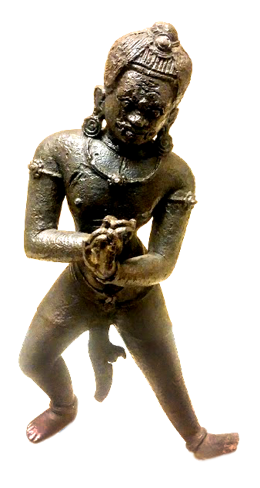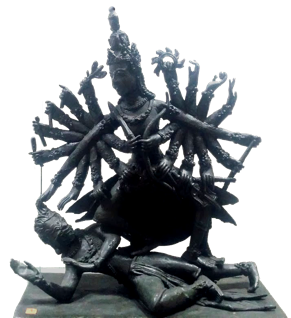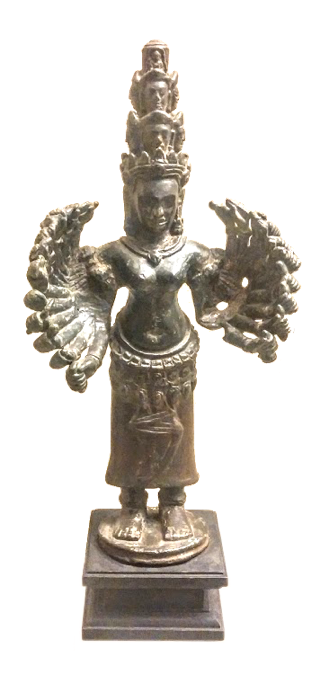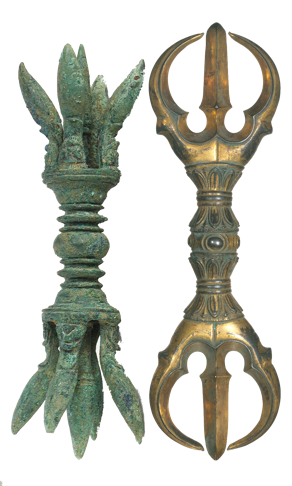XIII. AXIAL DIFFUSION, CONFUSION & ILLUSION: Preah Khan
Only thirty years separate the completion of Angkor Wat from the accession of Jayavarman VII in 1181 but they were in many ways the most politically and culturally eventful in the history of the Khmer Empire. Following the death of Suryavarman II around 1150 and of his two successors, Dharanindravarman II (1150-1165) and Yasovarman II (1160-1165,) a brahmin official, Tribhuvanadityavarman (1165-1177,) usurped the succession triggering a civil war as the ever-restive Khmer nobles jockeyed for advantage. One faction enlisted the aid of the Cham, their traditional enemies from what is now central Viet Nam, who used this as an invitation to sack and occupy Angkor Thom in 1177. After four years of warfare, the fifty-year-old Jayavarman VII (1181-1220,) son of Dharanindravarman II, drove the Cham back to the coast of the South China Sea and won back all Khmer territories, launching the last but most radical and ambitious building program in their history.
Although Buddhism had been tolerated and even encouraged at some previous Khmer courts, Jayavarman VII was the first avowed Buddhist to ascend the throne and the architectural innovations of his virtual reconstruction of the devastated Khmer Empire cannot be understood outside his attempts to institutionalize a form of that religion. This section and the next will use his two most ambitious foundations, Preah Khan and the Bayon, to explore how that monarch’s eclectic Buddhist beliefs might have contributed to the otherwise puzzling aberrations and innovations from both Hindu and Buddhist temple conventions found in the unprecedented number of monuments erected during his reign.
Vajrayana Mandala Visualization:
“Nirvana in an Afternoon?”
Jayavarman’s VII’s concept of Buddhism seems to have been inclusive and tolerant, in keeping with Khmer tradition, though the epigraphic record and architectural remains are notably vague about actual religious practices at Angkor. The presence in the stratigraphic evidence of a substantial number of Buddhist artifacts substantiates some observance of that religion, at least by the Khmer elite, from as early as the 10th Century. Conspicuous among these are statuettes of Hejavira (figure 19A,) a deity closely associated with Tantric or Vajrayana Buddhism, from Sans. > vajra, thunderbolt, (associated in Hinduism with Indra, the Vedic equivalent of Zeus or Jupiter,) metaphorically connoting “adamantine” or diamond hardness (figure 19D,) While many orthodox Buddhists have dismissed Vajrayana as a heretical “fast-track” to enlightenment, “satori lite,” Its practitioners prefer to think of it as the (Sans. > yana method; Sans. > yantra diagram, device) of “efficient results” or “skillful means.” (For a description of the three Buddhist “-yanas” see appendix IV.) Despite its reputation in the popular imagination, Vajrayana does not regard itself as heterodox or transgressive but as the final and most advanced of Buddha’s revelations, hence its self-description as the “Third Turning of the Wheel of Dharma.” Its foundational texts are held to have been written by Buddha himself before entering parinirvana or non-existence but concealed in caves until his adherents were sufficiently mature to understand their esoteric teachings. These “hidden sutras” were “discovered” starting around the 6th Century C.E. by Indian gurus who passed their teaching and techniques down through secretive Tantric parampara, “lineages” or orders.
Vajrayana novices were expected to have: 1) mastered Buddha’s teachings during his lifetime, as recorded in the Tripitaki, the “three baskets” of the Pali Canon, the only texts accepted as authentic by Theravada (Hinayana) Buddhists; 2) practiced the Mahayana sadhanas, yogas, meditative practices and other austerities leading to sunyata, the realization of the essential ”emptiness” of the world and self; 3) performed the four Vajrayana “preliminary practices” – 100,000 times each: (a) prostration before their Tantric guru, (b) repetition of the Vajrasattva mantra, (c) offerings to the particular yidam and mandala assigned them and (d) mastery of “guru yoga.” (These strictures, one suspects, would have been relaxed in the case of the Khmer monarch and his officials, preoccupied with the Empire’s governance.) They prepared neophytes for the abhisheka or “empowerment ritual” initiating them into a particular Vajrayana lineage, analogous to the abhisheka ceremony marking a Khmer monarch’s entry into the devaraja cult ,as detailed in the Sdok Kok Thom inscription of 1053. Only then were Tantric adepts deemed ready to engage in the four, primary Vajrayana sadhanas or techniques: 1) visualization of their yidam or personal bodhisattva; 2) “inner yoga,” using their “subtle” (as opposed to physical) body, their dharmakaya or acintya (imperceptible) essence; 3) sometimes breaking otherwise prohibited sexual and dietary taboos to demonstrate that good and evil, even dharma, were illusions; and 4) “resting in the nature of mind” or “Buddha consciousness” through the internalization of their mandala and dissolution of the subject / object dichotomy.
The symbolic “language” Vajrayana initiates use to articulate and experience their “Buddha nature” is visualization of their personal yidam’s mandalas (Sans. mandala > disk, circle > PIE man hand + do to give, cognate with mandate.) 1) First, a vajrasiddha or master assigns an adept a personal yidam or bodhisattva, based on his innate inclinations towards one of the five Buddha tathagatas, “families, natures” or “wisdoms.” 2) Next, starting from a dimensionless point within himself, his non-manifest “Buddha nature” or dharmakaya, the initiate’s “subtle Buddha energy” emanates along the cardinal axes four more deities, expressing aspects of their yidam’s “nature.” 3) These entities then project four more manifestations of that yidam around themselves, gradually articulating a fuller experience of its (and the adept’s) Buddha nature. (The number of deities in a mandala could thus be expressed as 4n+ 1 where n represents the repetition of four-way axial projections.) 4) Vajrayana practitioners would also project in the intercardinal directions, four “guardian kings” representing their yidam's powers to defend the mandala’s meditative or visualized space from “defilement” by the maras, the samsaric temptations to objectify their consciousness of the mandala, spawning desire. 5) Once the adept, his yidam and its manifestations are no longer experienced as separate, his “Buddha nature” has reached full expression. 6) This realization then causes the mandala to collapse and vanish into its initial, non-manifest state, like a Tibetan sand mandala swept away after days of meticulous construction. Vajrayana practitioners during the utpattikrama or “development phase,” when visualization is practiced, guard against the dualities of perceiver and perceived, center and periphery, by visualizing their mandalas “under erasure,” not as a blueprint, object or distinct deities but a pulsating “Buddha energy,” emanating and contracting into its dimensionless (niskala, apophatic, non-manifest,) unconditioned (nirguna, without mental categories, attributes or qualia,) non-originated state of emptiness. In terms of Buddhist epistemology, all manifestations, including visualizations, mandalas and the temples designed with them, are said to be “dependently originated” phenomena, “empty yet apparent,” in contrast with noumenal “Buddha consciousness” or tathagata, “thusness” or “suchness,” which is "adamantine" because devoid of form, concept or extension.
Such Vajrayana practices might have proved especially attractive to the Khmer elite since they did not demand a lifetime of monastic austerities like Mahayana Buddhism or the hundreds of reincarnations of Theravada doctrine. Tantra’s porous membrane between the divine and every day, its fluid metamorphoses into deity or yidam and back again, may also have resonated with indigenous Khmer beliefs, including the deification of ancestors as syncretized in the Hindu devaraja cult. As best as can be determined, the king experienced a kind of entheogenesis, not unlike the Vajrayana adept’s visualization of his yidam, during an occult ritual administered by a lineage of brahmins descended from the one who initiated the cult in 802, re-enacted on the upper terraces of each monarch’s “temple mountain.” The clandestine transmission of the cult’s thaumaturgy and the king’s exclusive ability to commune with the devaraja linga would explain the cryptic references in the public, epigraphic record, including those of Jayavarman VII’s foundations.*
The process of visualizing a Vajrayana mandala inevitably has parallels with the mandalas used in the construction of temples, as prescribed in the Vastu Shastra, the sacred Hindu text on temple architecture, (discussed in section II. “Architectural Cosmogony: ‘Aedicular Expansion.’ ”) For example, a vastu purusha mandala, such as the one illustrated in figure 3, or a temple like the Baphuon in figure 16, is generated through of a similar process of axial and lateral projections as a yidam’s visualization in a mandala. This suggests a number of questions whose answers can only be speculative which, nonetheless, might clarify the frame of reference in which the last Angkorian temples were built. For example, to what extent did Jayavarman VII’s monastic foundations attempt to reconcile the square Hindu mandala, the previous basis for Khmer temple design, with the usually circular Vajrayana mandalas, syncretizing the two faiths architecturally as he seems to have tried doctrinally? How is the Bayon’s round, central tower, rising from the redented square of its 3rd terrace and its rectangular 1st and 2nd, related to the more compressed but geometrically similar “zone of transition,” for example, at the stupas of Wat Lok Moli in Chiang Mai or Loka-Hteikpan at Bagan? Could the famous “face towers” above the gates of Angkor Thom, his capital, and the terraces of the Bayon, his state temple, whose inscrutable identity remains an embarrassment to Angkorian scholarship, express the multiple, but ultimately illusory, aspects of a single yidam or bodhisattva, emanating from a single “Buddha nature” or dhyani Buddha, itself a manifestation of a non-dualistic (advaita,) non-manifest Adi-Buddha? Did the spatial ambivalence and transience of Vajrayana mandalas contribute to the seemingly diffuse proliferation of shrines at Jayavarman VII’s monastic foundations, including Preah Khan, analyzed in the paragraphs below?
*Evidentiary absence might be said to be the necessary precondition for any occult, metaphysical or “faith-based” ideology, secular or sacred; faith is, by definition, always blind. Its obvious advantage is that it cannot be empirically disproved since it lacks empirical existence. From this, the credent or credulous erroneously infer its truth. Specific Vajrayana practices, such as mandala visualization under Jayavarman VII, must remain conjectural, in contrast with the undeniable presence of Tantric devotional objects at Angkor.
FIGURE 19: VAJRAYANA RITUAL OBJECTS

19A: HEJAVIRA, NATIONAL MUSEUM, BANGKOK
(EARLY 11TH CENTURY)

19B: PRAJNAPARAMITA TRAMPLING SHIVA, NATIONAL MUSEUM BANGKOK (MID-12TH CENTURY)

19C: ELEVEN-HEADED PRAJNAPARAMITA, NATIONAL
MUSEUM, BANGKOK (EARLY 13TH CENTURY)

19D: VAJRAS, PRIVATE COLLECTION (LATE 12TH CENTURY)